
Our Geological Wonderland: How geology made America great
By the middle of the 20th century, the United States had become a leading industrialized nation. Amazingly enough, it only took about 2 billion years of geologic time, and a bit of luck, for this historic event to have come to fruition. Clearly there is a story here.
Almost everyone takes a United States history class in high school, and some also take similar history classes in college. Most of these classes study population growth, social and political events, wars and other conflicts, and industrial events and discoveries that have occurred since America was colonized by Europeans in 1607.
One significant event mentioned in such classes is the Industrial Revolution. Historians now consider that there were two such revolutions. The first occurred in Great Britain roughly from about 1760 to the mid-1800s with the development of mechanization, the use of water and steam power, and early production of iron products.
The second, which is the one most people learn about, began in the mid-1800s and spread from Great Britain into Europe and then “across the pond” to the United States. A major innovation beginning about 1870 was getting energy from burning coal to manufacture steel. In turn steel promoted invention and development of more advanced machinery. In turn this machinery allowed for development of mass production techniques, construction of transportation arteries such as canals and railroads, and then development of electrical grids, which began in 1889.
This industrialization also fostered rapid growth of cities based on manufacturing, and by the mid-1900s the United States had become a world leader in manufacturing and production. Combining this industrialization with medical advances such as antibiotics and immunizations created a rapid growth in population, especially since the 1950s (Figure 1).

A combination of political, social and economic events is used to explain the rise of the United States into an industrial power. However, there is another factor that played a major role in this development. That factor is the geological history of North America, which provided a vast array of natural resources to support industrial development.
Fortuitous abundance and close geographic distribution of natural resources such as iron ore, coal, oil and natural gas were discovered during the mid-1800s to the early 1900s. These resources were exploited and used to develop a rapidly expanding industrial network in the eastern and Great Lakes portions of the United States.
Many financiers and industrialists became involved with this development. Empires were built, fortunes were made, and this led to the coining of the term “robber baron”, a term first used by the New York Times in 1859 and then more commonly applied in the late1800s-early 1900s. Although to some degree this term is accurate, it should be noted that these people also provided strong leadership and organizational abilities that built up economic conditions in the United States.
Natural resources
Distribution of natural resources in North America has played a major role in advancing the fortunes of the United States. Resources such as precious metals, rare earth elements, uranium, and others are abundant, but the initial industrial growth of the country was initially based on iron ore and coal. Geologic occurrence and distribution of these two resources and their proximity to one another played a pivotal role in this development.
Precambrian age iron ore
Rocks of the North American continent occur in what are termed separate tectonic provinces. These provinces are primarily distinguished from each other based on differing geologic ages of rocks in each province. Overall, this pattern shows an episodic growth of the continent for over 3.5 billion years (Figure 2).
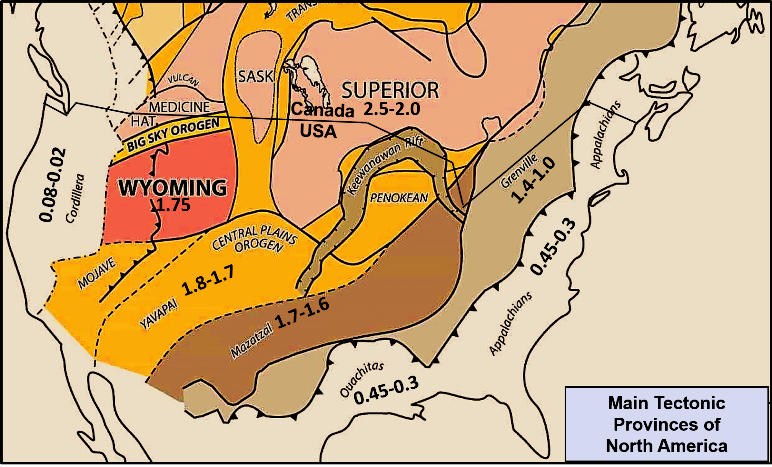
This growth was a result of plate tectonics which periodically resulted in collisions of continents. These collisions resulted in formation of mountain ranges and various geological features such as faults, folds, and mineralization. A similar growth pattern through geologic time is also recognized on other continentals and provides further supporting evidence for plate tectonics.
Precambrian time is defined as occurring from the origin of Earth about 4.5 billion years ago until about 540 million years ago. The Superior Province around Lake Superior contains Precambrian age deformed rocks ranging in age from about 2 to 2.5 billion years old. Exposed at the surface or just below the surface are distinctive iron-bearing sedimentary rocks known as banded iron formations. These rocks are exposed in northeast trending mostly eroded ancient mountain ranges around Lake Superior (Figure 3).
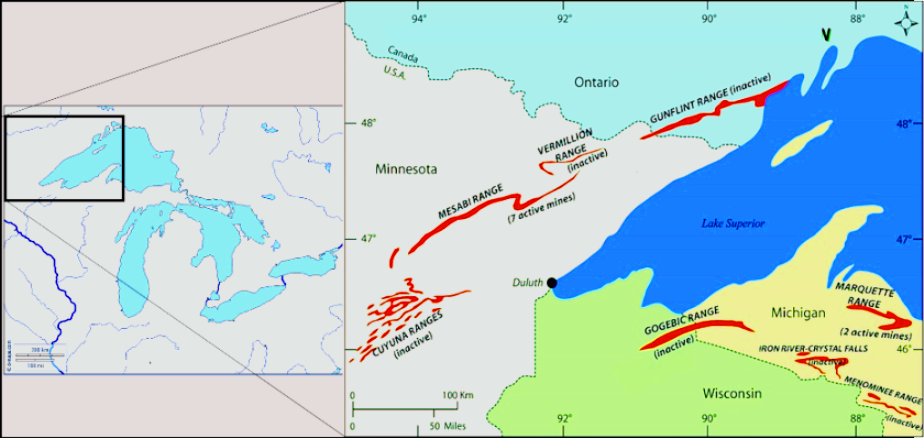
Over 60 percent of iron ore reserves of North America occur in these banded iron formations (Figure 4). Globally, these unusual rocks are almost all of Precambrian age, with most formed between 3.2 and 1.8 billion years ago. They were initially deposited as sediments in shallow ocean environments and they can be found on most continents. They predate the time when Earth’s atmosphere and hydrosphere became completely oxidizing.
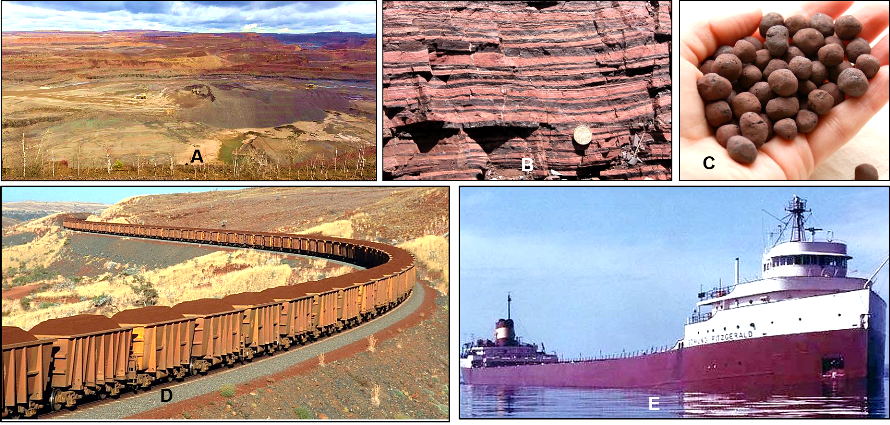
Banded iron formations are distinctive sedimentary rocks. The banding resulted from episodes when oxygen gas was present, which oxidized iron in the sediments (red layers) alternating with episodes when oxygen gas was absent and no oxidation occurred. This has been interpreted to indicate the oxygen resulted from episodic blooms of photosynthesizing blue-green bacteria, much like those occurring today as “algal or bacterial blooms” in warm shallow marine environments. When conditions changed and the bacteria died off, oxygen was depleted.
Development of iron mining around the Great Lakes began slowly in the mid-1800s. As a result of increasing demand, mining accelerated in the last half of the 19th century. Bessemer Converters were used to produce cast iron and then steel. More efficient transportation methods were developed using railroads on land and ore ships on the Great Lakes. As a result, the United States became a major world producer and supplier of steel during the first half of the 20th century.
Late Paleozoic age coal
Energy source for expansion of steel production was provided by abundant coal deposits in the Appalachian Mountains. Thus, a source of abundant iron ore and a relatively close occurrence of extensive coal deposits combined to produce rapid industrial growth in states bordering the southern Great Lakes.
The Appalachian Tectonic Province contains large and widespread surface and underground deposits of coal, which initially formed in the Appalachian Basin (Figure 5).

This coal formed from Carboniferous age sedimentary rocks (325–300 million years ago) that contained large amounts of buried plant remains. These plant-bearing sediments were deposited in marginal marine and lowland forests and swamplands (like modern day Everglades) in warm moist climates. These buried materials were subsequently altered by heat and pressure resulting from a plate tectonic collision that formed the supercontinent Pangaea and the Appalachian Mountains (Figure 6).
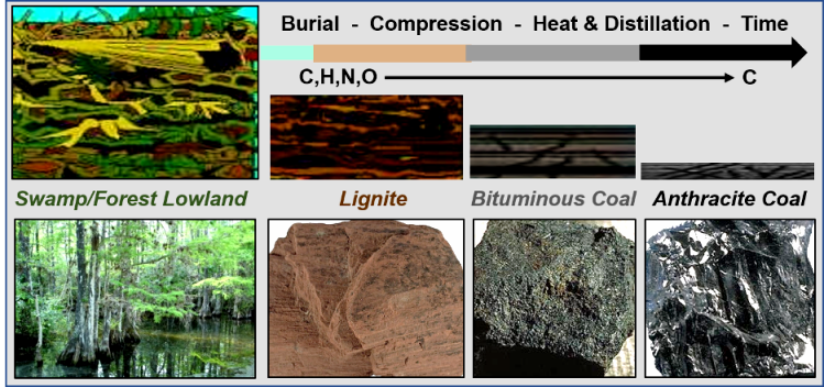
On a global scale, deposits of coal do not occur in rocks older than about 350 million years (Carboniferous time). The reason for this is that terrestrial plants had not developed in significant abundance to provide a source until that time.
Within the Appalachian region, the first small coal mining operations began around 1770. Significant expansion in mining did not occur until the early 1800s. Although the resources were there, a demand for coal had not yet developed. Beginning about 1840, when decent roads and early railroad lines were built, Appalachian coal became a staple for producing heat energy for converting the iron ore from the Great Lakes region. Mining accelerated after the Civil War and by the late 1800s had become a major economic force.
The rise of an Industrial Empire and its subsequent stagnation
In 1856, the Englishman Henry Bessemer took out a patent on what became known as the Bessemer Converter, which was used to convert iron ore (pig iron) into steel (Figure 7). The process was refined and then brought to the United States where the first steel mill was opened in 1875. Andrew Carnegie became a leading figure in steel production and was one of the first “robber barons.”

The first half of the 20th Century saw an enormous increase in the manufacture of steel, with the rise of U.S. Steel, Bethlehem Steel, and others. Mining of Appalachian coal rapidly expanded to provide energy for steel production for products like steel for buildings and automobiles (Figure 8). During the 1960s steel began to be produced by different types of furnaces, such as the electric arc furnace, which were more efficient then Bessemer Converters.

Steel production increased rapidly beginning in the 1940s and reached a peak in the mid-1960s and late 1970s. Decline in mining and production began in the early 1980s and has resulted in a significant decrease in manufacturing and loss or decline of major industries in the United States (Figure 9).
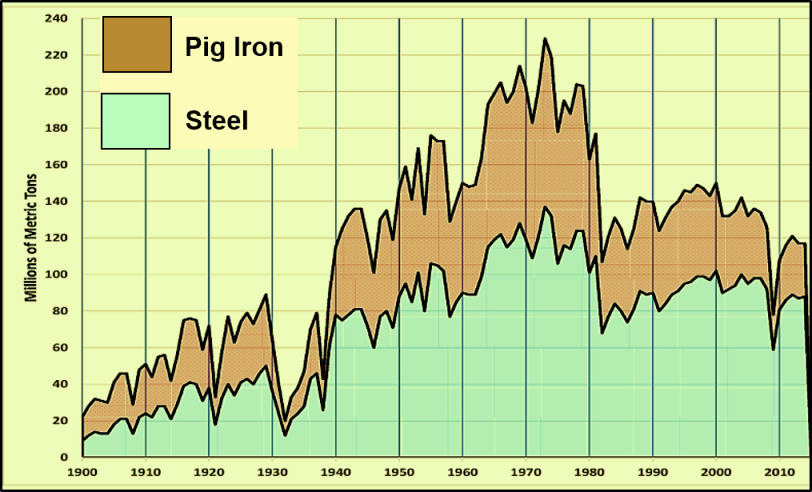
In the last half of the 20th Century. steel production decreased in the United States. The resources were still available, but technological innovations were not taken advantage of. This corporate blunder coupled with lower production costs in other countries and use of domestic recycled steel forced some steel companies into bankruptcy. This has greatly decreased manufacturing jobs and created economic hardships in states around the Great Lakes region.
Coal mining began to increase rapidly in the late 1800s, stabilized with fluctuations until about 1960, and then again began to increase rapidly. This increase was the result of population growth and a voracious need for more electrical energy, primarily produced by coal-fired power plants (Figure 10).
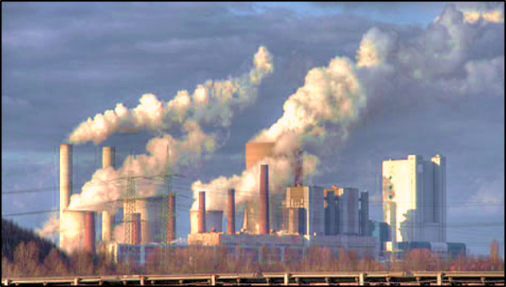
However, beginning about 2000, coal began to be phased out and replaced by natural gas, nuclear power plants, and various “green energy” power production (Figure 11). This has created economic hardships in the Appalachian region. By 2019, the decline in use of coal resulted in bankruptcy and closure of many coal mining companies.

Fortuitous abundance and geographic proximity of iron ore and coal played a very significant part in the development of the United States as a major industrial nation. During the last decades of the 20th Century and into the 21st Century, steel production and manufacturing and coal mining have decreased. There have been significant job losses in both industries as well as other manufacturing industries, and it remains to be seen what the future results of this situation will be.
Articles related to “Our Geological Wonderland: How geology made America great”
Our Geological Wonderland: The Kayenta Formation, an ancient Jurassic Park
Our Geological Wonderland: A self-guided field trip in and around St. George
Our Geological Wonderland: Examining the Biblical Great Flood



